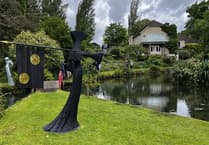An expert on languages used thousands of years ago who is also a board games historian gave an entertaining lecture to The Arts Society Farnham on May 21.
The speaker, Irving Finkel, is a British philologist, Assyriologist and assistant keeper of ancient Mesopotamian script, languages and cultures in the Department of the Middle East at the British Museum, specialising in cuneiform inscriptions on clay tablets from ancient Mesopotamia.
Irving has written articles and books on ancient Babylon and is on the editorial board of the Board Game Studies Journal.
His language skills helped him determine the rules of the Royal Game of Ur, which originated in 2600 BC.
In the 1920s Sir Leonard Wooley’s excavations of Ur in southern Iraq discovered a cemetery where the Sumerian royal family were buried.
The family took with them a board game for two players made out of a block of wood with a drawer in it - featuring a track inlaid with shell, cornelian and lapis lazuli - assuming they would play it over tea in their next life. Also found was a beautiful set of rules from 177 BC.
This game exists in Iran, further east and in north-west India. Some believe it originated, as did chess, in India. It existed in Afghanistan and Crete in different forms, such as inscribed on bricks.
An arts society spokesperson said: “His hunt for clues has led the speaker halfway across the world in pursuit of this, the most successful board game of antiquity that survived for 3,000 years until backgammon was invented.
“On top of that, the game survived, unnoticed, in south-west India until modern times. The result is a board game that we could play in the company of Tutankhamun and that can compete with any popular two-person race game on the market today.”





Comments
This article has no comments yet. Be the first to leave a comment.